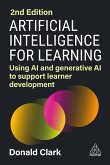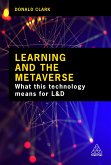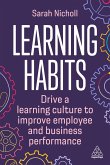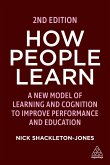Colin Beard, Wilson, John P., Ph.D.
Experiential Learning
A Practical Guide for Training, Coaching and Education
Colin Beard, Wilson, John P., Ph.D.
Experiential Learning
A Practical Guide for Training, Coaching and Education
- Broschiertes Buch
- Merkliste
- Auf die Merkliste
- Bewerten Bewerten
- Teilen
- Produkt teilen
- Produkterinnerung
- Produkterinnerung
Equip yourself with the theory and practical tools to deliver experience-based learning that develops skills, improves performance and drives behavioural change.
Andere Kunden interessierten sich auch für
![Artificial Intelligence for Learning Artificial Intelligence for Learning]() Donald ClarkArtificial Intelligence for Learning30,99 €
Donald ClarkArtificial Intelligence for Learning30,99 €![Learning and the Metaverse Learning and the Metaverse]() Donald ClarkLearning and the Metaverse41,99 €
Donald ClarkLearning and the Metaverse41,99 €![Learning Habits Learning Habits]() Sarah NichollLearning Habits44,99 €
Sarah NichollLearning Habits44,99 €![Collaborative Learning Collaborative Learning]() Nick HernandezCollaborative Learning44,99 €
Nick HernandezCollaborative Learning44,99 €![Vocational Assessor Handbook Vocational Assessor Handbook]() Ian GreerVocational Assessor Handbook43,99 €
Ian GreerVocational Assessor Handbook43,99 €![How People Learn How People Learn]() Nick Shackleton-JonesHow People Learn31,31 €
Nick Shackleton-JonesHow People Learn31,31 €![Berufliches Lernen in Schüler- und Juniorenfirmen Berufliches Lernen in Schüler- und Juniorenfirmen]() Melanie HillebrandBerufliches Lernen in Schüler- und Juniorenfirmen73,25 €
Melanie HillebrandBerufliches Lernen in Schüler- und Juniorenfirmen73,25 €-
-
-
Equip yourself with the theory and practical tools to deliver experience-based learning that develops skills, improves performance and drives behavioural change.
Produktdetails
- Produktdetails
- Verlag: Kogan Page Ltd
- Artikelnr. des Verlages: 8475
- 4 Revised edition
- Seitenzahl: 376
- Erscheinungstermin: 3. August 2018
- Englisch
- Abmessung: 234mm x 156mm x 24mm
- Gewicht: 560g
- ISBN-13: 9780749483036
- ISBN-10: 0749483032
- Artikelnr.: 50428972
- Herstellerkennzeichnung
- Libri GmbH
- Europaallee 1
- 36244 Bad Hersfeld
- gpsr@libri.de
- Verlag: Kogan Page Ltd
- Artikelnr. des Verlages: 8475
- 4 Revised edition
- Seitenzahl: 376
- Erscheinungstermin: 3. August 2018
- Englisch
- Abmessung: 234mm x 156mm x 24mm
- Gewicht: 560g
- ISBN-13: 9780749483036
- ISBN-10: 0749483032
- Artikelnr.: 50428972
- Herstellerkennzeichnung
- Libri GmbH
- Europaallee 1
- 36244 Bad Hersfeld
- gpsr@libri.de
Colin Beard is a professor and National Teaching Fellow at Sheffield Business School. He works with leading global public and private organizations to design and facilitate experiential learning strategies. He is the author of The Experiential Learning Toolkit, also published by Kogan Page. John P. Wilson holds positions at Sheffield and Oxford Universities. His experience in education and consultancy spans a variety of countries and sectors, including aerospace engineering, banking, law and pharmaceuticals. He has written and edited a number of books and articles, and has blogged for the CIPD.
Chapter
01: A brief introduction to experiential learning; Section
ONE: Experiential learning: foundations and fundamentals; Chapter
02: Practical answers to some theoretical questions; Chapter
03: Designing, delivering and evaluating experiential learning; Section
TWO: The Learning Combination Lock model; Chapter
04: The outer
world learning environment: other humans, other living creatures, and spaces and places (the belonging dimension); Chapter
05: Experiential learning activities, behaviours and actions (the doing dimension); Chapter
06: Sensory experience and sensory intelligence (SI) (the sensing dimension); Chapter
07: Experience and emotions (the feeling dimension); Chapter
08: Experience, knowing and intelligence (the knowing dimension); Chapter
09: Deeper learning (the being dimension); Section
THREE: Experiential learning and the future; Chapter
10: Imagining, experiencing and learning from the future;
01: A brief introduction to experiential learning; Section
ONE: Experiential learning: foundations and fundamentals; Chapter
02: Practical answers to some theoretical questions; Chapter
03: Designing, delivering and evaluating experiential learning; Section
TWO: The Learning Combination Lock model; Chapter
04: The outer
world learning environment: other humans, other living creatures, and spaces and places (the belonging dimension); Chapter
05: Experiential learning activities, behaviours and actions (the doing dimension); Chapter
06: Sensory experience and sensory intelligence (SI) (the sensing dimension); Chapter
07: Experience and emotions (the feeling dimension); Chapter
08: Experience, knowing and intelligence (the knowing dimension); Chapter
09: Deeper learning (the being dimension); Section
THREE: Experiential learning and the future; Chapter
10: Imagining, experiencing and learning from the future;
Chapter
01: A brief introduction to experiential learning; Section
ONE: Experiential learning: foundations and fundamentals; Chapter
02: Practical answers to some theoretical questions; Chapter
03: Designing, delivering and evaluating experiential learning; Section
TWO: The Learning Combination Lock model; Chapter
04: The outer
world learning environment: other humans, other living creatures, and spaces and places (the belonging dimension); Chapter
05: Experiential learning activities, behaviours and actions (the doing dimension); Chapter
06: Sensory experience and sensory intelligence (SI) (the sensing dimension); Chapter
07: Experience and emotions (the feeling dimension); Chapter
08: Experience, knowing and intelligence (the knowing dimension); Chapter
09: Deeper learning (the being dimension); Section
THREE: Experiential learning and the future; Chapter
10: Imagining, experiencing and learning from the future;
01: A brief introduction to experiential learning; Section
ONE: Experiential learning: foundations and fundamentals; Chapter
02: Practical answers to some theoretical questions; Chapter
03: Designing, delivering and evaluating experiential learning; Section
TWO: The Learning Combination Lock model; Chapter
04: The outer
world learning environment: other humans, other living creatures, and spaces and places (the belonging dimension); Chapter
05: Experiential learning activities, behaviours and actions (the doing dimension); Chapter
06: Sensory experience and sensory intelligence (SI) (the sensing dimension); Chapter
07: Experience and emotions (the feeling dimension); Chapter
08: Experience, knowing and intelligence (the knowing dimension); Chapter
09: Deeper learning (the being dimension); Section
THREE: Experiential learning and the future; Chapter
10: Imagining, experiencing and learning from the future;









